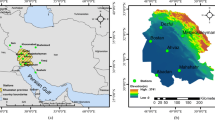Abstract
Partial Least Squares Regression (PLSR) is used to study monthly changes in the influence of the Arctic Oscillation (AO) on spring, summer and autumn air temperature over China with the January 500 hPa geopotential height data from 1951 to 2004 and monthly temperature data from January to November at 160 stations in China. Several AO indices have been defined with the 500-hPa geopotential data and the index defined as the first principal component of the normalized geopotential data is best to be used to study the influence of the AO on SAT (surface air temperature) in China. There are three modes through which the AO in winter influences SAT in China. The influence of the AO on SAT in China changes monthly and is stronger in spring and summer than in autumn. The main influenced regions are Northeast China and the Changjiang River drainage area.
Similar content being viewed by others
References
Baldwin, M. P., and T. J. Dunkerton, 1999: Propagation of the Arctic Oscillation from the stratosphere to the troposphere. J. Geophys. Res., 104, 30937–30946.
Dickson, R. R., and Coauthors, 2000: The Arctic Ocean response to the North Atlantic Oscillation. J. Climate, 13, 2671–2696.
Frank, I. E., and J. H. Friedman, 1993: A statistical view of some chemometrics regression tools. Technometrics, 35(2), 109–147.
Gong, D. Y., and C. H. Ho, 2003: Arctic oscillation signals in the East Asian summer monsoon. J. Geophys. Res., 108(D2), ACL14, DOI: 10.1029/2002JD002193.
Gong, D. Y., and S. W. Wang, 2003: Influence of Arctic Oscillation on winter climate over China. J. Geophys. Res., 13, 208–216.
Gong, D. Y., and C. H. Ho, 2004: Intra-seasonal variability of winter temperature over East Asia. International Journal of Climatology, 24(2), 131–144.
Gong, D. Y., S. W. Wang, and J. H. Zhu, 2001: East Asian winter monsoon and Arctic Oscillation. Geophys. Res. Lett., 28, 2073–2076.
Gong, D. Y., S. W. Wang, and J. H. Zhu, 2002: Significant relationship between spring AO and the summer rainfall along the Yangtze River. Chinese Science Bulletin, 7, 546–547.
Gong, D. Y., S. W. Wang, and J. H. Zhu, 2004: Arctic Oscillation influence on daily temperature variance in winter over China. Chinese Science Bulletin, 49(6), 637–642.
Hartmann, D. L, J. M. Wallace, V. Limpasuvan, D. W. J. Thompson, and J. R. Holton, 2000: Can ozone depletion and greenhouse warming interact to produce rapid climate change? Proc. National Academy of Sciences, 97, 1412–1417.
Hoerling, M. P., J. W. Hurrell, and T. Xu, 2001: Tropical origins for recent North Atlantic climate change. Science, 292, 90–92.
Ju, J., J. Lu, J. Cao, and J. Ren, 2005: Possible impacts of the Arctic Oscillation on the interdecadal variation of summer monsoon rainfall in East Asia. Adv. Atmos. Sci., 22, 39–48.
Li, J., and J. X. L. Wang, 2003: A new North Atlantic Oscillation index and its variability. Adv. Atmos. Sci., 20, 661–676.
Rogers, J. C., 1990: Patterns of low-frequency monthly sea level pressure variability (1899–1986) and associated wave cyclone frequencies. J. Climate, 3, 1364–1379.
Stone, M., and R. Brooks, 1990: Continuum regression: Cross-validated sequentially constructed prediction embracing ordinary least squares, partial least squares, and principal components regression. Journal of the Royal Statistical Society (Series B), 52(2), 237–269.
Thompson, D.W. J., and J. M. Wallace, 1998: The Arctic Oscillation signature in the wintertime geopotential height and temperature fields. Geophys. Res. Lett., 25, 1297–1300.
Thompson, D.W. J., M. P. Baldwin, and J. M. Wallace, 2002: Stratospheric connection to Northern Hemisphere wintertime weather: Implications for prediction. J. Climate, 15, 1421–1428.
Wallace, J. M., 2000: North Atlantic Oscillation/ Northern Hemisphere annular mode, one phenomenon, two paradigms. Quart. J. Roy. Meteor. Soc., 126, 791–805.
Wang, J., and M. Ikeda, 2000: Arctic Oscillation and Arctic Sea-Ice Oscillation. Geophys. Res. Lett., 27(9), 1287–1290.
Wu, B. Y., and J. Wang, 2002a: Winter Arctic Oscillation, Siberian High and the East Asia winter monsoon. Geophys. Res. Lett., 29(19), 1897–1900.
Wu, B. Y., and J. Wang, 2002b: Possible impacts of winter Arctic Oscillation on Siberian High and the East Asia winter monsoon and sea-ice extent. Adv. Atmos. Sci., 19, 297–320.
Author information
Authors and Affiliations
Corresponding author
Rights and permissions
About this article
Cite this article
Huang, J., Tan, B., Suo, L. et al. Monthly changes in the influence of the Arctic Oscillation on surface air temperature over China. Adv. Atmos. Sci. 24, 799–807 (2007). https://doi.org/10.1007/s00376-007-0799-x
Received:
Revised:
Issue Date:
DOI: https://doi.org/10.1007/s00376-007-0799-x




